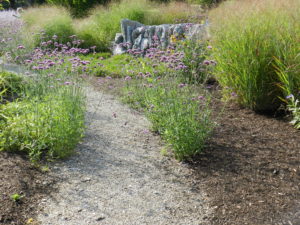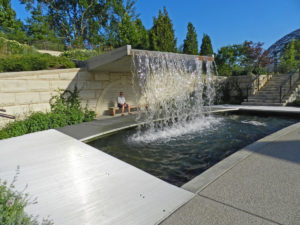In my ongoing discussion of designing for the senses, I’ve already mentioned smell and touch. This time, I want to talk about that of hearing.

Gravel path
Plants, wind, water, and wildlife are all contributing notes in the music of a garden. One note we rarely think of is our presence in the garden. As we walk, we add sounds just by being there. The surface on which we walk will determine what type of sound we are creating: padding (on smooth stone or brick), crunching (on gravel or), or rustling (on dried leaves in the fall). Even if we hear no sound, the critters in our gardens do.

Baptisia australis pods in August that will turn black in fall
A necessary element of this sense is the wind. In June, Baptisia australis (False Indigo) blooms for about three weeks. After that, pods develop, green at first, and eventually turning black. By that time, the seeds inside the pods are quite dry. If you stand close by and listen when the wind blows, you can hear the seeds rattling inside the pods.

Chasmanthium latifoliumf oats in October
In the shady garden, if you plant Chasmanthium latifolium (Northern Sea Oats), the inflorescence develops in July at which time the oats are green. In the fall, they become bronze and then beige. At that point, they are quite dry and rattle when the breezes blow.
Even those grasses that have more delicate inflorescences have foliage that sways in the wind and we can hear that wind-swept sound. We also hear leaves rustling in the trees when the wind blows.

Metal sculpture (by Jill Nooney) that spins in the wind
We can enhance the wind by adding ornaments with sound to the garden. Wind chimes are quite popular and their musicality or lack thereof depends on the design and material. The sounds can be soothing, jangly, softly clacking, or clattery – it all depends on what you want to hear. What all of them will do is make you more aware of the wind and its strength. Another ornament often added is the whirligig which twirls only when the wind is blowing.

Ceramic urn in basin provides soft, slow drip

Modernistic waterfall with long bench below at Des Moines Botanical Garden
Another element of sound is water. There are an infinite variety of water features that can produce any sound, from a very subtle slow drip to a loud roar. The decision is merely a matter of taste and budget. The sound of water can draw you into a garden; you hear it and then find that you must discover the source. Your water feature can be as simple as a recirculating fountain or as complicated as a waterfall and pond.
Finally, bird song adds sound to the garden. Some songs are raucous; others are cheery. If you want to hear all the sounds in your garden, you will have to be patient and you will have to take the time to sit down and close your eyes. Then you will really hear.


1 Comment